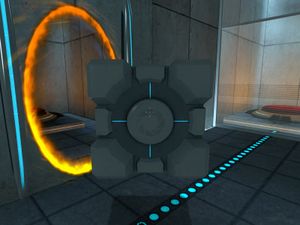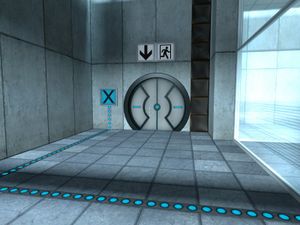Conon26845 (talk | contribs) mNo edit summary |
Conon26845 (talk | contribs) mNo edit summary |
||
| Line 9: | Line 9: | ||
[[Image:Portal_01_button.jpg|thumb|left|A portal in action.]] | [[Image:Portal_01_button.jpg|thumb|left|A portal in action.]] | ||
{{YouTube|video=oeUjVkJ7seY|title=Portal Trailer|duration=2:21|description=An introduction to portals.}} | {{YouTube|video=oeUjVkJ7seY|title=Portal Trailer|duration=2:21|description=An introduction to portals.}} | ||
Portals are the main method of getting around and solving puzzles in Portal | Portals are the main method of getting around and solving puzzles in Portal. They are either created by the [[#Aperture Science Handheld Portal Device|portal gun]], or are pre-existing in a chamber. A portal has two ends; a blue end, and an orange end. You (or objects you send through) can travel between the two in either direction. | ||
One of the key features of portals is that momentum is conserved as you go through; if an object is going fast when it enters a portal, it will come out the other end at the same speed, ''regardless of any re-orientation which might occur''. One important practical application of this is to climb up otherwise insurmountable objects: place | One of the key features of portals is that momentum is conserved as you go through; if an object is going fast when it enters a portal, it will come out the other end at the same speed, ''regardless of any re-orientation which might occur''. One important practical application of this is to climb up otherwise insurmountable objects: place one end of a portal at the bottom of a pit, and one facing the top of the object to be scaled, and then fall into the first end of the portal. You will be projected out of the second end and come to rest (if everything's been positioned properly) on top of the previously-insurmountable object. | ||
{{-}} | {{-}} | ||
==Chamberlocks== | ==Chamberlocks== | ||
Revision as of 22:26, 11 October 2008
Aperture Science Handheld Portal Device

The "portal device" is your only tool, and holds immense power. With it, you can create either, or both, ends of a portal, and solve the various puzzles in each chamber. By default, ![]() will create the blue end of a portal, and
will create the blue end of a portal, and ![]() will create the orange end.
will create the orange end.
Portals

An introduction to portals.
Portals are the main method of getting around and solving puzzles in Portal. They are either created by the portal gun, or are pre-existing in a chamber. A portal has two ends; a blue end, and an orange end. You (or objects you send through) can travel between the two in either direction. One of the key features of portals is that momentum is conserved as you go through; if an object is going fast when it enters a portal, it will come out the other end at the same speed, regardless of any re-orientation which might occur. One important practical application of this is to climb up otherwise insurmountable objects: place one end of a portal at the bottom of a pit, and one facing the top of the object to be scaled, and then fall into the first end of the portal. You will be projected out of the second end and come to rest (if everything's been positioned properly) on top of the previously-insurmountable object.
Chamberlocks

Chamberlocks are the exit points for a chamber, and the objective of each chamber is to reach them. In front of every chamberlock is a field which will vapourise unauthorised material such as cubes.
1500MW Aperture Science Heavy-Duty Supercolliding Superbuttons

One of the several devices used to set puzzles in Portal is the superbutton (referred to in this guide simply as a "button", despite the normality such a description implies). They are typically linked to doors with clearly-visible tracks, but require a weight constantly on them to keep doors open; cubes are quite useful for this.
Aperture Science Weighted Storage Cubes

The stereotypical physics block; you can pick them up, move them around, throw them, and – more importantly – leave them on buttons, and push them through portals. They're simply referred to in this guide as "cubes".
Doors


These are – at least to begin with – the main obstacle to progression through the chambers. Typically linked to buttons, doors will only stay open when the button is depressed. The button, or buttons, with which a door is linked can be determined by following the wires from the door to the buttons.
Aperture Science High-Energy Pellets

Pellets are small balls of energy also found in Half-Life 2. They are created and fired by pellet launchers, and should be directed towards pellet receivers, which will – like buttons – power things such as doors once they've captured a pellet. Be careful around pellets, as they will instantly kill you if you touch them. Remember that pellets will disintegrate if they are only bouncing off walls for a few bounces — they need to go through portals or bounce off pellet launchers to remain intact.
Pellet launcher

Pellet launchers create pellets. They will only allow one pellet at a time to exist, so will only launch a new pellet when the old one disintegrates — typically because it is only bouncing between two walls, instead of a wall and a portal, or a pellet launcher and something else.
Pellet receiver

Pellet receivers act much like buttons in that they power things when they have received a pellet. They are connected to the device they power with wires, which can be traced to find a pellet receiver's associated object. Once a pellet receiver has captured a pellet, it will close, and can capture no more pellets. Conversely, it will never release the pellet it has captured, either.